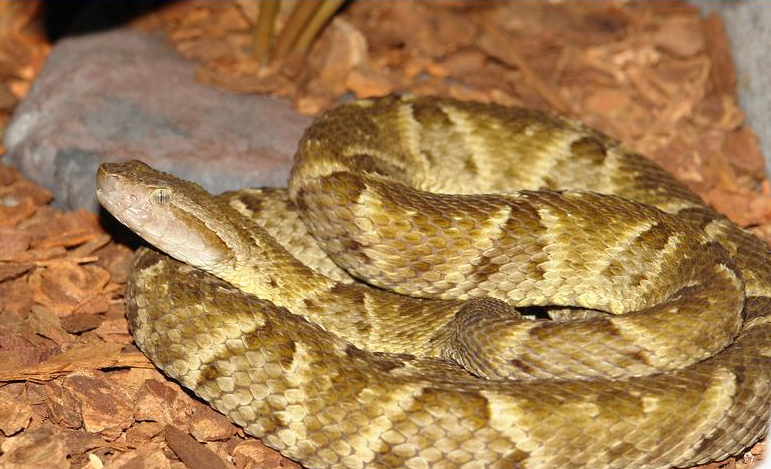- Bothrops
Taxobox
name = "Bothrops"

image_caption = Common lancehead, "B. atrox"
regnum =Animal ia
phylum = Chordata
subphylum = Vertebrata
classis = Reptilia
ordo =Squamata
subordo =Serpentes
familia =Viperidae
subfamilia =Crotalinae
genus = "Bothrops"
genus_authority = Wagler, 1824
synonyms = * "Bothrops" - Wagler, 1824
* "Rhinocerophis" - Garman, 1881McDiarmid RW, Campbell JA, Touré T. 1999. Snake Species of the World: A Taxonomic and Geographic Reference, vol. 1. Herpetologists' League. 511 pp. ISBN 1-893777-00-6 (series). ISBN 1-893777-01-4 (volume).]:"Common names: lanceheads,Campbell JA, Lamar WW. 2004. The Venomous Reptiles of the Western Hemisphere. Comstock Publishing Associates, Ithaca and London. 870 pp. 1500 plates. ISBN 0-8014-4141-2.] American lanceheads, American lance-headed vipers.U.S. Navy. 1991. Poisonous Snakes of the World. US Govt. New York: Dover Publications Inc. 203 pp. ISBN 0-486-26629-X.] ""Bothrops" is a
genus of venomous pitvipers found inCentral America ,South America . The generic name is derived from the Greek words "bothros" and "ops" that mean "pit" and "eye" or "face"; an allusion to the heat-sensitiveloreal pit organs. Members of this genus are responsible for more human deaths in theAmericas than any other group of venomous snakes. Currently, 32 species are recognized.ITIS|ID=209554|taxon=Bothrops|year=2006|date=3 November]Description
These snakes range from small, never growing to more than 50-70 cm, to large at over 200 cm in length. Most are characterized by having a sharp "canthus rostralis" and an unelevated snout.
The arrangement of the scales on top of the head is extremely variable; the number of intrasupraoculars may be anything from 3 to 14. Usually there are 7-9
supralabials and 9-11sublabials . There are 21-29 midbodydorsal scales , 139-240ventral scales and 30-86subcaudals , which are generally divided.Geographic range
Found in northeastern
Mexico (Tamaulipas ) southward through Central andSouth America toArgentina . Also occurs on the islands ofSaint Lucia andMartinique in theLesser Antilles , as well as onIlha da Queimada Grande off the coast ofBrazil .Behavior
Most species are nocturnal, although a few that are found at higher altitudes are active during the day. Otherwise they may be seen on cloudy days or during periods of rain. Most are terrestrial, even though all are capable of climbing. One in particular, "B. insularis", has a reputation for often being found in trees.
Venom
Members of this
genus are responsible for more fatalities in theAmericas than any other group ofvenomous snake s. In this regard, the most important species are "B. asper", "B. atrox" and "B. jararaca". Without treatment, the fatality rate is estimated to be about 7%, but with treatment this is reduced to 0.5-3%.Typical symptoms of bothropic envenomation include immediate burning pain, dizziness, nausea, vomiting, sweating, headache, massive swelling of the bitten extremity, hemorrhagic
bleb s, localnecrosis , bleeding from the nose and gums,ecchymosis , erythemia,hypotension ,tachycardia ,coagulopathy with hypofibrinogenemia andthrombocytopenia ,hematemesis ,melena ,epistaxis ,hematuria , intracerebralhemorrhage andrenal failure secondary to hypotension and bilateral cortical necrosis. There is usually some discoloration around the bite site andrash es may develop on thetorso or the extremities.In general, death results from hypotension secondary to
hypovolemia , renal failure andintracranial hemorrhage. Common complications include necrosis and renal failure secondary tohypovolemic shock and the toxic effects of the venom.pecies
"*) Not including the nominate subspecies."
T)Type species .Taxonomy
Other (new) species may be encountered in literature, such as:
* "B. alcatraz" - Marques, Martins & Sazima, 2002. Range:Brazil (São Paulo). Common name: jararaca-de-Alcatrazes.
* "B. muriciensis" - Ferrarezzi & Freire, 2001. Range: northeastern Brazil (Alagoas ). Common name: Murici lancehead.ee also
*
List of crotaline species and subspecies
*
*
*
*
*Snakebite References
External links
*
* [http://www.herpbreeder.com/worldspecies/Snakes/vipers/bothrops.htm "Bothrops"] at [http://www.herpbreeder.com/ Herpbreeder.com] . Accessed26 September 2006 .
* [http://www.snakeman1982.com/ListBothrops.asp List of "Bothrops" Complex by scientific name] at [http://www.snakeman1982.com/ Jadin Expeditions] . Accessed7 November 2006 .
* [http://www.serpenti.it/nomirettili.htm Nomi Rettili Italiano - Inglese] at [http://www.serpenti.it/ serpenti.it] . Accessed7 November 2006 .
* [http://www.itg.be/itg/DistanceLearning/LectureNotesVandenEndenE/imagehtml/ppages/CD_1091_045c.htm Graphic image of "B. atrox" bite] at [http://www.itg.be/itg/ Institute of Tropical Medicine, Antwerp] . Accessed26 June 2007 .
*. Accessed6 December 2007 .
*. Accessed6 December 2007 .
*. Accessed6 December 2007 .
Wikimedia Foundation. 2010.
